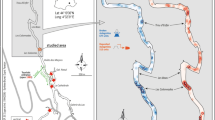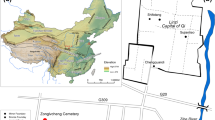Abstract
Until recently, every industry with geometric microliths in Central Asia has been classified as Mesolithic solely on the basis that this technology appeared quite late in the region. The situation was further complicated by the absence of absolute dates for Upper Paleolithic and Mesolithic sites from this region. Recent research has proved a clear association between the earliest geometric microliths in Central Asia and the Upper Paleolithic Kulbulakian culture (Shugnou, layer 1; Kulbulak, layer 2.1). The most comprehensive archeological collection in Central Asia that documents the shift from the production of non-geometric microliths (backed bladelet, Arzheneh points) to geometric microliths (scalene triangles) in a very early chronological context is Dodekatym-2 site. The main morphometric characteristics of the Central Asian Upper Paleolithic geometric microliths correspond to the development of the Upper Paleolithic and Epipaleolithic of the Near East (Masraquan cultures) and the Middle East (Zarzian culture). The absolute dates available for the Dodecatym-2 site are older than presently known ones for the early Epipaleolithic Levantine industries with geometric microliths, thus making it possible to conclude that Central Asia was at least one of the microlitization origin centers.












Similar content being viewed by others
References
Bar-Yosef O (1970) The Epipalaeolithic culture of Palestine. Dissertation, Hebrew University
Bar-Yosef O (1998) On the nature of transitions: the middle to upper Palaeolithic and the Neolithic revolution. Camb Archaeol J 8(2):141–163. https://doi.org/10.1017/S0959774300000986
Belfer-Сohen A, Gorring-Morris N (2002) Why microliths? Microlithization in the Levant. In: Elston RG, Kuhn SL (eds) Thinking small: global perspectives on microlithic technologies. Santa Fe, NM: American Anthropological Association, pp 57–68
Belfer-Сohen A, Gorring-Morris N (2014) The upper Palaeolithic and earlier epi-Palaeolithic of western Asia. The Cambridge World Prehistory 3:1381–1407. https://doi.org/10.1017/CHO9781139017831.088
Brown KS, Marean CW, Jacobs Z, Schoville BJ, Oestmo S, Fisher EC, Bernatchez J, Karkanas P, Matthews T (2012) An early and enduring advanced technology originating 71,000 years ago in South Africa. Nature 491:590–593. https://doi.org/10.1038/nature11660
Bronk Ramsey C (2009) Bayesian analysis of radiocarbon dates. Radiocarbon 51:337–360. https://doi.org/10.1017/S0033822200033865
Byrd BF (1994) Late Quaternary hunter-gatherer complexes in the Levant between 20,000 and 10,000 BP. In bar-Yosef O and Kra RS (ed.) late Quaternary chronology and paleoclimates of the eastern Mediterranean. Tucson. Radiocarbon:265–276
Davis RS, Ranov VA (1999) Recent works on the Paleolithic of Central Asia. Evol Anthropol 8:186–193
Flas D, Kolobova K, Pavlenok K, Vandenberghe D., De Dapper M., Leschisnky S., Viola B., Islamov U., Derevianko AP, Cauwe N (2010) Preliminary results of new excavations at the Palaeolithic site of Kulbulak (Uzbekistan). Antiquity 84, 325. http://antiquity.ac.uk/projgall/flas325/. Accessed 25 Mar 2017
Ghasidian E, Bretzke K, Conard N (2017) Excavations at Ghar-e Boof in the Fars Province of Iran and its bearing on models for the evolution of the upper Palaeolithic in the Zagros Mountains. J Anthropol Archaeol 47:33–49
Gisis I, Gilead I (1977) Lagama III. In: Bar-Yosef O, Phillips JL (eds) Prehistoric investigations in Gebel Maghara, northern Sinai. QEDEM 7, the Hebrew University of, Jerusalem, pp 85–101
Gorring-Morris N (1987) At the edge: terminal Pleistocene hunter-gatherers in the Negev and Sinai. In BAR international series 361. Oxford: Archaeopress
Gorring-Morris N (1995) Complex hunter/gatherers at the end of the Paleolithic. In: Levy T (ed) The archaeology of society in the holy land. Leicester University Press, London, pp 141–167
Henry DO (1974) The utilization of the microburin technique in the Levant. Paleorient 2:389–398
Henry DO (1989) From foraging to agriculture: the Levant at the end of the ice age. University of Pennsylvania Press, Philadelphia
Hole F (1997) Paleoenvironment and human Society in the Jezireh of northern Mesopotamia 20,000–6000 BP. Paléorient 23:39–49
Hole F, Flannery KV (1967) The prehistory of southwestern Iran: a preliminary report. Proceedings of the Prehistoric Society 33:147–206
Kolobova KA (2014) Verhnij paleolit zapadnogo Pamiro-Tjan’-Shanja. Habilitation, Dissertation, Novosibirsk (in Russian)
Kolobova KA, Krivoshapkin AI, Derevianko AP, Islamov UI (2011) The upper Paleolithic site of Dodekatym-2 in Uzbekistan. Archaeol Ethnol Anthropol Eurasia 39:2–21. https://doi.org/10.1016/j.aeae.2012.02.002
Kot M (2017) Bifacial and unifacial technology: a real difference or a problem of typoetechnological approach? The example of the Ehringsdorf assemblage. Quatern Int 428:66–78
Krivoshapkin A (2012) Obirahmatskii variant perehoda ot srednego k verhnemu paleolitu v Tsentral’noi Azii. Habilitation, Dissertation, Novosibirsk (in Russian)
Leroi-Gourhan A (1988) Dictionnaire de la prehistoire. P.U.F, Paris
Lewis L. (2017) Early microlithic technologies and behavioural variability in Southern Africa and South Asia, Azania: Archaeological Research in Africa. BAR Publishing: Oxford
Monigal K (2004) Lithic assemblage from buran-Kaya III. Level C. In: Chabai VP, Monigal K, Marks AE (eds) The middle Paleolithic and early upper Paleolithic of Eastern Crimea. Liège: ERAUL, 104, pp 57–77
Munro N (2009) Epipaleolithic subsistence intensification in the southern Levant: the faunal evidence. In: J-J Hublin and M P Richards (ed.) the evolution of hominin diets: integrating approaches to the study of Palaeolithic subsistence, pp 141–155. https://doi.org/10.1007/978-1-4020-9699-0_10
Nadel D (2003) The Ohalo II flint assemblage and the beginning of the Epipalaeolithic in the Jordan Valley. In: Belfer-Cohen A, Gorring-Morris N (eds) More than meet the eyes: studies on upper Paleolithic diversity in the near east. The Short Run Press, Oxford, pp 216–230
Nadel D, Grinberg U, Boaretto E, Werker E (2006) Wooden objects from Ohalo II (23,000 cal BP), Jordan Valley, Israel. J Hum Evol 50:644–662
Nadel D, Sorel J (2005) The Flint assemblages from three successive floors in hut 1 (Ohalo II): a note on technological aspects. Journal of the Israel prehistoric. Society 35:189–200
Nuzhnyy D (2000) Development of microlithic projectile weapons in the stone age. Anthropologie et Prehistoire 111:95–101
Olszewski D (1993a) Zarzian microliths from Warwasi rockshelter, Iran: scalene triangles as arrow components. In: Peterkin G, Bricker H, Mellars P (eds) Hunting and animal exploitation in the later Paleolithic and Mesolithic of Eurasia. Washington (DC), American Anthropological Association, pp 199–205
Olszewski D (1993b) The Zarzian occupation at Warwasi Rockshelter, Iran. In: Dibble H, Olszewski D (eds) The Paleolithic prehistory of the Zagros-Taurus. University of Pennsylvania, Philadelphia, pp 207–236
Olszewski D (2012) The Zarzian in the context of the Epipaleolithic Middle East. J Humanit 19:1–20
Pastoors A (2000) Standardization and individuality in the production process of bifacial tools e leaf-shaped scrapers from the middle Paleolithic open air site Sare Kaya I (Crimea). In: Orschiedt J, Weniger G-C (eds) Neanderthals and modern humans, discussing the transition: central and Eastern Europe from 50.000–30.000 B.P. Neanderthal museum, Mettmann, pp 243–255
Petraglia M, Clarkson C, Boivin N, Haslam M, Korisettar R, Chaubey G, Ditchfield P, Fuller D, Miracle P, Harris C, Connell K, James H, Koshy J (2009) Population increase and environmental deterioration correspond with microlithic innovations in South Asia ca. 35,000 years ago. Proc Natl Acad Sci U S A 106:12261–12266. https://doi.org/10.1073/pnas.0810842106
Ranov VA, Karimova GR (2005) Kamennyi vek Afgano-Tadzhikskoi depressii (Stone Age of the Afghan-Tajik Depression). Devashtish Press: Dushanbe (in Russian)
Ranov VA, Kolobova KA, Krivoshapkin AI (2012) The upper paleolithic assemblages of Shugnou, Tajikistan. Archaeol Ethnol Anthropol Eurasia 2:2–24. https://doi.org/10.1016/j.aeae.2012.08.002
Reimer PJ, Bard E, Bayliss AW, Beck J, Blackwell PG, Ramsey CB, Buck CE, Cheng H, Edwards RL, Friedrich M, Grootes PM, Guilderson TP, Haflidason H, Hajdas I, Hatté C, Heaton TJ, Hoffmann DL, Hogg AG, Hughen KA, Kaiser KF, Kromer B, Manning SW, Niu M, Reimer RW, Richards DA, Scott EM, Southon JR, Staff RA, Turney CSM, van der Plicht J (2013) IntCal13 and Marine13 radiocarbon age calibration curves 0–50,000 years cal bp. Radiocarbon 55:1869–1887
Richter T, Garrard AN, Allock S, Maher LA (2011) Interaction before agriculture: exchanging material and sharing knowledge in the final Pleistocene Levant. Camb Archaeol J 21:95–114. https://doi.org/10.1017/S0959774311000060
Robinson E, Sellet F (2018) Lithic technological organization and Paleoenvironmental change: global and diachronic perspectives. Springer, New-York. https://doi.org/10.1007/978-3-319-64407-3_1
Rybin EP (2014) Tools, beads and migrations: specific cultural traits in the initial upper Paleolithic of southern Siberia and Central Asia. Quatern Int 347:39–52. https://doi.org/10.1016/j.quaint.2014.04.031
Smith P (1986) Paleolithic archaeology in Iran. American Institute of Iranian Studies, Philadelphia
Tixier J (1963) Typologie de L’Épipaléolithique du Maghreb. Art et Métiers Graphiques, Paris
Tsanova T (2013) The beginning of the upper Paleolithic in the Iranian Zagros. A taphonomic approach and techno-economic comparison of early Baradostian assemblages from Warwasi and Yafteh (Iran). J Hum Evol 65:39–64
Tsuneki A (2013) Proto-Neolithic caves and neolitization in southern Zagros. In: Matthews R, Nashli HF (eds) The Neolithisation of Iran. Short run press, Oxford, pp 84–96
Vandenberghe DAG, Flas D, De Dapper M, Van Nieuland J, Kolobova K, Pavlenok K, Islamov U, De Pelsmaeker E, Debeer A-E, Buylaert J-P (2014) Revisiting the Palaeolithic site of Kulbulak (Uzbekistan): first results from luminescence dating. Quatern Int 324:180–189. https://doi.org/10.1016/j.quaint.2013.09.011
Vardi J, Gilead I (2009) On the definition of errors in contexts of craft specialization: Krukowski microburins from the Beit Eshel chalcolithic flint workshop. In: Rosen SA, Roux V (eds) Techniques and people: anthropological perspectives on technology in the archaeology of the proto-historic and early historic periods in the southern Levant. de Boccard, Paris, pp 125–135
Wahida G (1999) The Zarzian industry of the Zagros Mountains. In: Davies W, Charles R (eds) Dorothy Garrod and the progress of the Paleolithic: studies in the prehistoric archaeology of the near east and Europe. Oxbow Books, Oxford, pp 181–208
Wilkins J, Brown KS, Oestmo S, Pereira T, Ranhorn K, Schoville BJ, Marean CW (2017) Lithic technological responses to late Pleistocene glacial cycling at pinnacle point. Site 5-6, South Africa. PLoS One 12(3):e0174051. https://doi.org/10.1371/journal.pone.0174051
Yaroshevich A, Nadel D, Tsatskin A (2013) Composite projectiles and hafting technologies at Ohalo II (23 ka, Israel): analyses of impact fractures, morphometric characteristics and adhesive remains on microlithic tools. J Archaeol Sci 40:4009–4023. https://doi.org/10.1016/j.jas.2013.05.017
Yaroshevich A, Kaufman D, Nuzhnyy D, Bar-Yosef O, Weinsteiner-Evron M (2010) Design and performance of microlith implemented projectiles during the Middle and the Late Epipaleolithic of the Levant: experimental and archaeological evidence. J Archaeol Sci 37:368–388. https://doi.org/10.1016/j.jas.2009.09.050
Ziegler M, Simon MH, Hall IR, Barker S, Stringer C, Zahn R (2013) Development of middle stone age innovation linked to rapid climate change. Nat Commun 4:1905. https://doi.org/10.1038/ncomms2897
Acknowledgements
We are grateful to the Russian Scientific Foundation (RNF), project #14-50-00036 “Multidisciplinary Research in Archaeology and Ethnography of Northern and Central Asia” for the support of analytical part of this research. The attributive analysis of Upper Paleolithic geometric and non-geometric microliths was supported by Council on grants of the President of the Russian Federation #МD-2845.2017.6. Comparisons of Central Asian Upper Paleolithic with Levantine and Zagros techno-complexes have been supported by RFBR project #18-09-00222 А. Drawings were made by N.V. Vavilina and A.V. Abdulmanova from the Institute of Archeology and Ethnography SB RAS. The authors are indebted to their colleagues from the Institute of Archeology and Ethnography SB RAS, the Institute of Archeology of the Academy of Sciences of Uzbekistan, for the fruitful discussions during the field studies and the preparation of this article.
Author information
Authors and Affiliations
Corresponding author
Rights and permissions
About this article
Cite this article
Kolobova, K., Krivoshapkin, A. & Shnaider, S. Early geometric microlith technology in Central Asia. Archaeol Anthropol Sci 11, 1407–1419 (2019). https://doi.org/10.1007/s12520-018-0613-y
Received:
Accepted:
Published:
Issue Date:
DOI: https://doi.org/10.1007/s12520-018-0613-y




